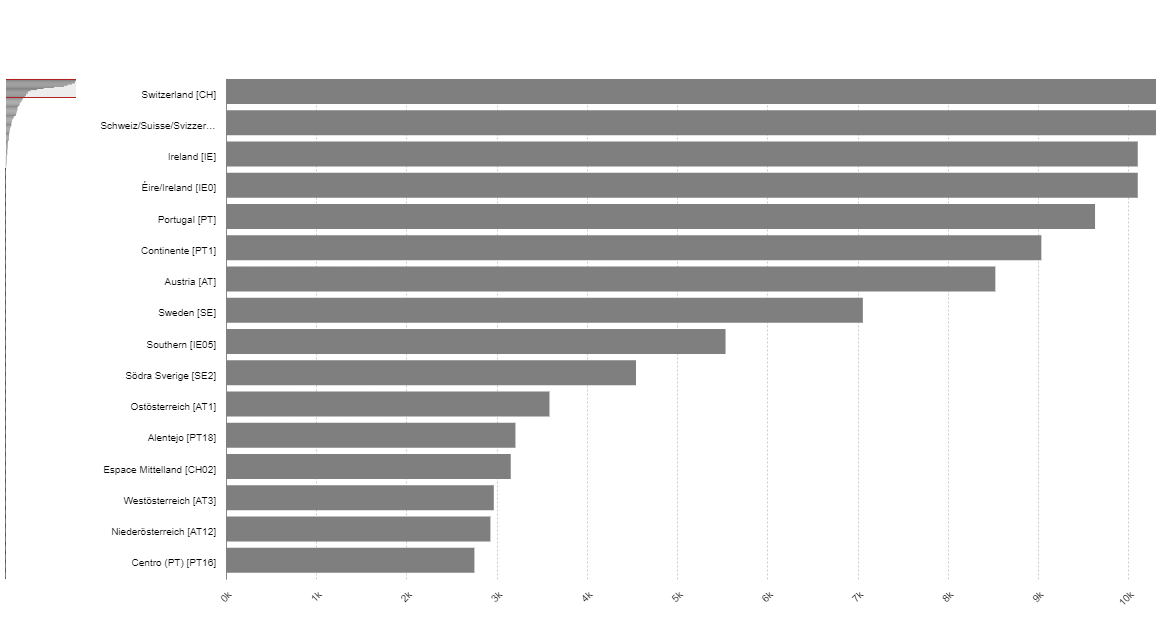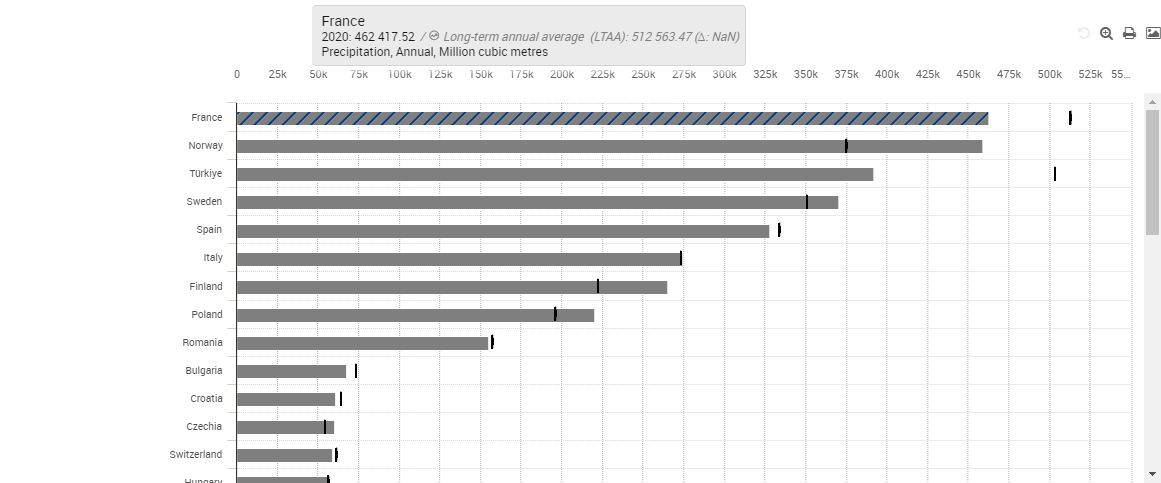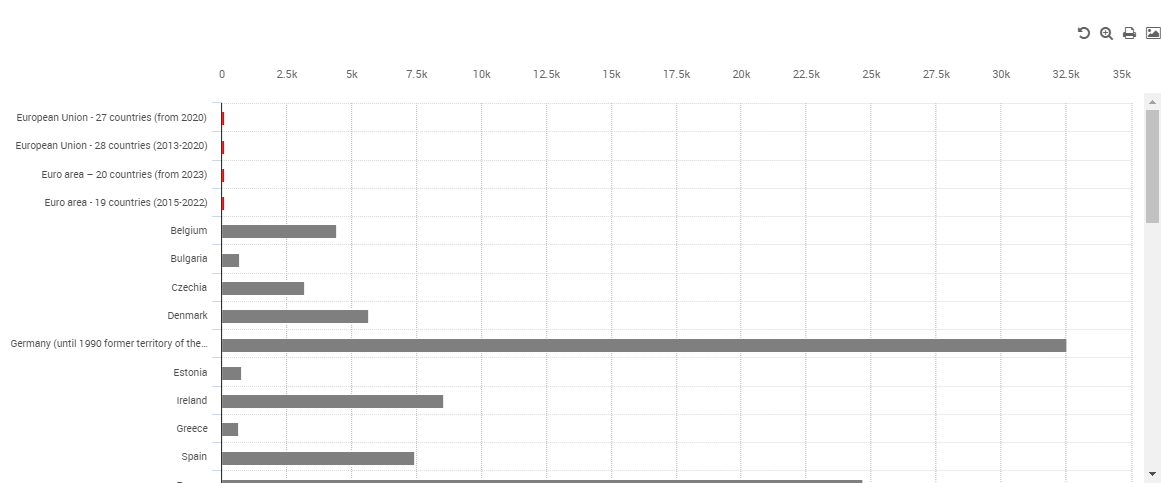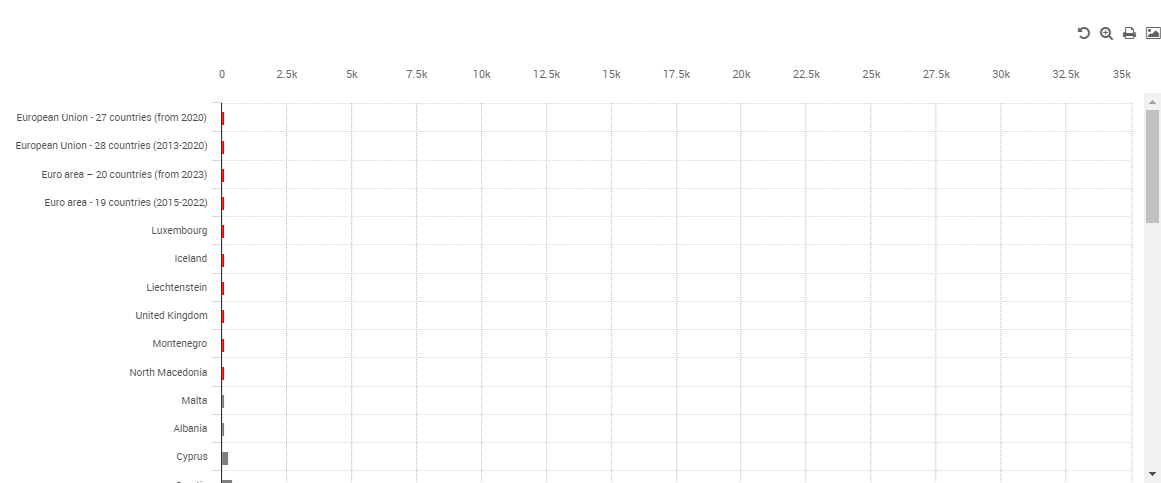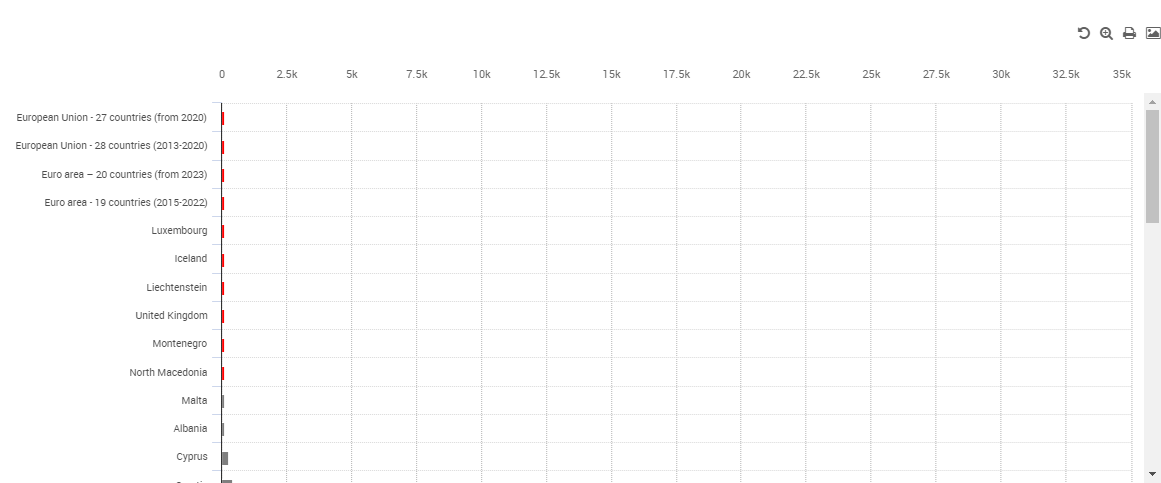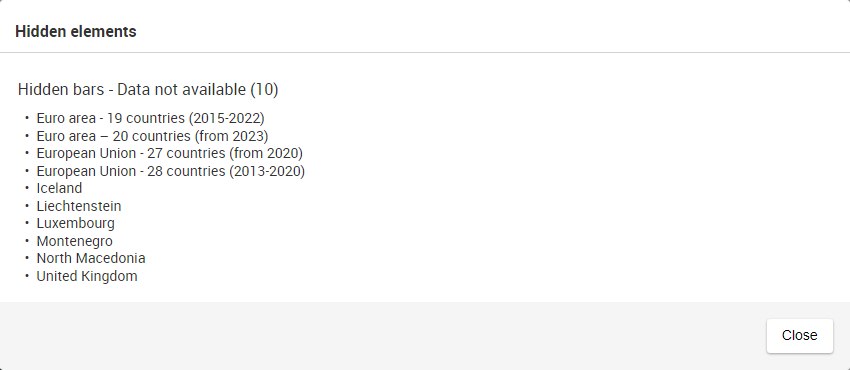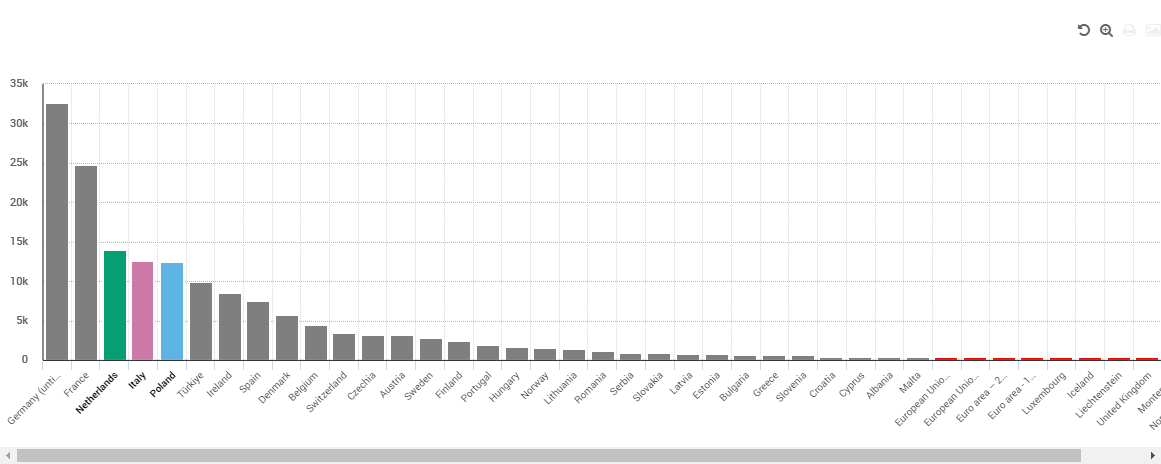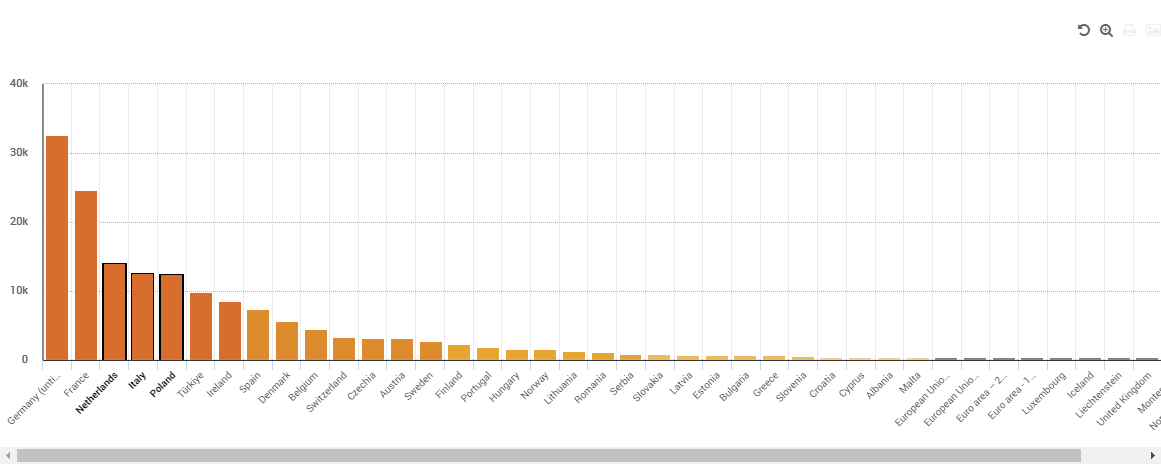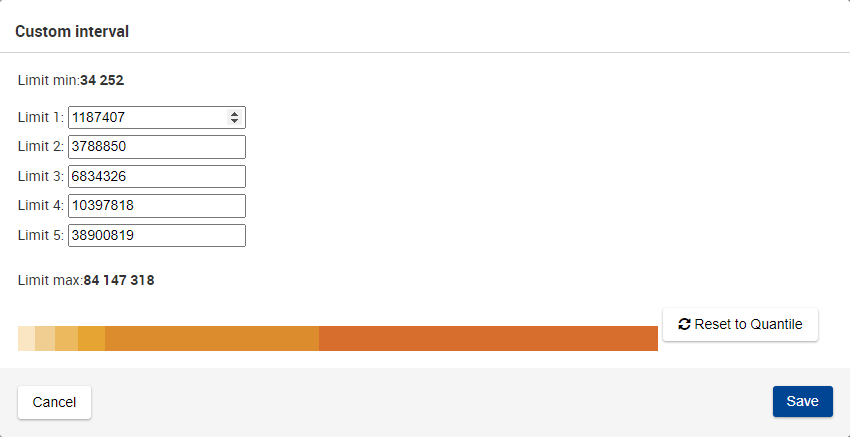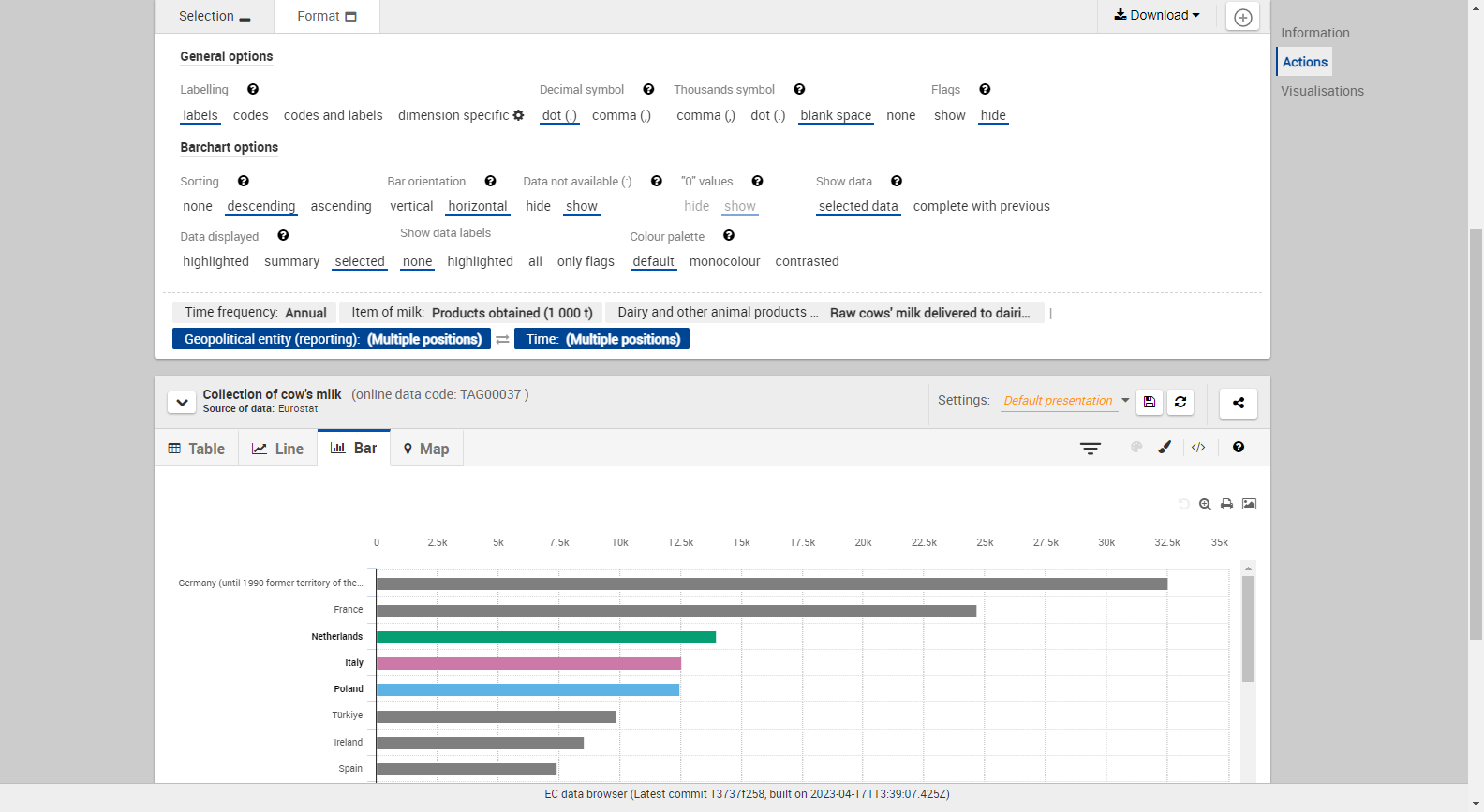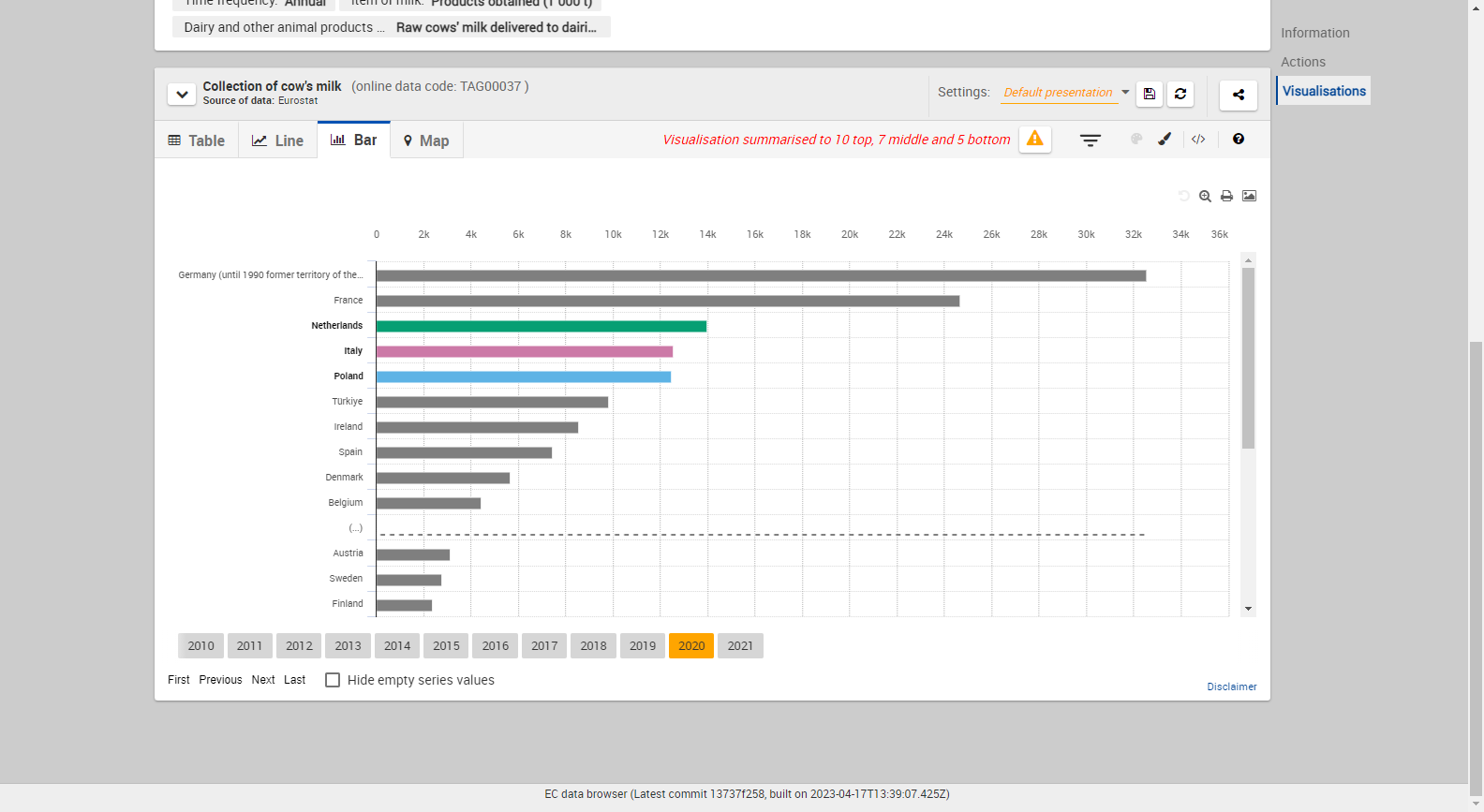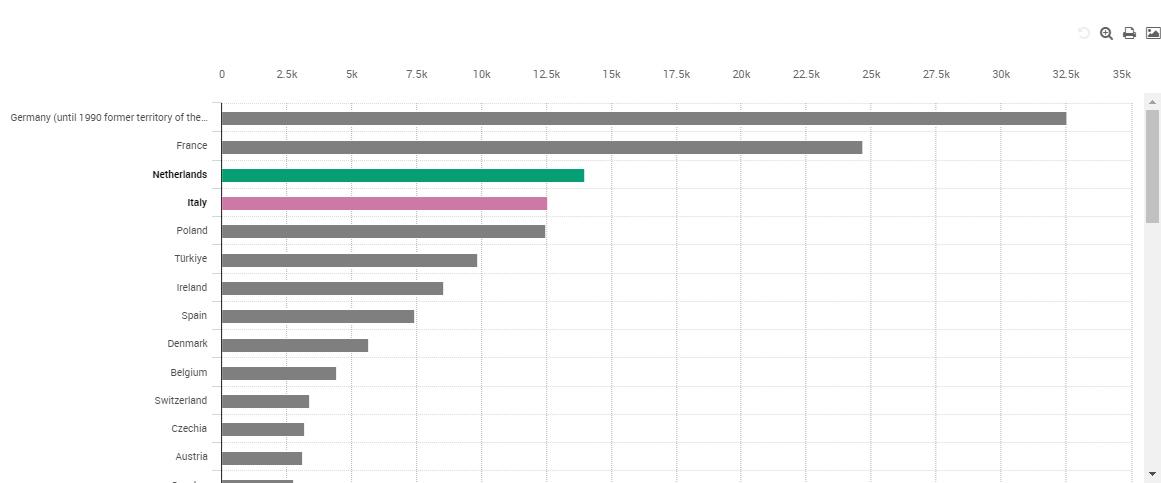Data visualisation
Click on Bar tab to visualize the dataset through a bar chart.
Mouse over a bar, e.g. Turkey in this case. A tooltip with information about the observation appears.
Click on a bar. This bar gets highlighted and stay highlighted also when mouse hovering other bars.
Navigable visualisation
When the chart contains more than 300 bars, a navigation side-panel is added. This side-panel displays the overview of the data and allows to navigate in the chart
Dimensions Management
The X-Axis dimension is used for the categories of the chart
The Series dimension displays below the bar chart as sheets navigation:
Visualisation actions
| Button | Action |
|---|---|
| Print the bar chart with the print feature. | |
Export the bar chart with the export feature. Different download formats are supported: | |
Embed the bar chart with the export feature The button Copy is available to automatically select all the 'webtool snippet' code and copy it into the pasteboard. |
Export and print features have limitations. See this section for more information.
Format options
Click on Format to set the different format options of the bar chart.
Labelling, Decimal symbol and Thousands symbol options are described on this page.
Flags options
Show (default value): When hovering a bar, flags are shown in the tooltip above the bar chart:
Hide: Flags are hidden:
Series Attribute options
Some datasets contain a "serie attribute". This attribute provides additional information, like:
TARGET: Objective to reach
LTAA: Long-Term Annual Average
When displaying such dataset in a Bar chart, the serie attribute will be visible in the tooltip, placed above the Bar chart, which is displayed each time the user mouses over a bar. Example:
Barchart sorting options
None: No specific sort order is applied:
Descending (default setting): Descending sort order is applied:
Ascending: Ascending sort order is applied:
Bar orientation options
Vertical: bars are displayed vertically:
Horizontal (default setting): bars are displayed horizontally:
Options concerning the display of not available data
Data not available
Hide (default view setting): no bar is displayed when an observation is not available:
Show: A red line is displayed when an observation is not available:
If one or more bar is masked using this option, an orange exclamation mark () appears at the top right of the bar chart. When clicking on this button, a modal appears, showing the list of currently hidden bars:
"0" values options
Show (default view setting): the observation is displayed even with a "0" value observation
Hide: the observation is not displayed in case of "0" value observation
If one or more bar is masked using this option, an orange exclamation mark () appears at the top right of the bar chart. When clicking on this button, a modal appears, showing the list of currently hidden bars:
Colour palette options
The available options are:
Default: All the bars have a gray background (unless highlighted):
Monocolour: The background of the bars ranges from dark orange to light orange:
Contrasted: The background of the bars uses a high-contrast colour palette:
Classification method
This selector appears only if the Colour palette selector is not set to “Default”.
Classification method selector sets the bar classification for the currently displayed Bar chart (Quantile in the provided example):
Quantile: Each interval contains the same amount of observations
Equal intervals: Each interval has the same size (with “size” defined as the difference between the upper limit and the lower limit of each interval)
Custom intervals: Each interval’s size limits are customizable by dragging the cursor to the desired value. Alternatively, you can set the new limits in the popup which is displayed when clicking on one of the limit points:
When first accessing this window, the default limit values are the ones defined in Quantile.
When setting new limits, in case there are more than 1, they cannot be lower than the previous or greater than the next. Otherwise, an error is displayed:
In case the value limits have been previously modified, a new button is available, which will set the values to the previous ones:
Reset to previous valuesOr alternatively, you can set the default quantile values by clicking on Reset to Quantile button.
Amount of classes options
This selector appears only if the Colour palette selector is not set to “Default”.
Amount of classes selector sets the amount of classes to be used, with a minimum of two and a maximum of twelve.
Show data options
By default, the Data Browser displays the data in Bar chart corresponding to the currently selected position in the page by selector under the Bar chart:
However, the Show data selector provides to the user another way to manage the situation where a statistical data is missing for a specific position (for example, a specific year):
The available options are:
Selected data (default value): the Bar chart will only display the data related to the position selected in the page by selector under the Bar chart.
Complete with previous: if possible, the Bar chart will display the data related to the position selected in the page by selector under the Bar chart. If no data is available, previous data will be used (see example below).
This selector is not available in the following situations:
If there is no Time dimension in the dataset
If the Time dimension is in the X-Axis dimension (in the Selection tab)
Example
The example is based on the following settings:
Dimensions layout:
Selected year (in the page-by selector under the bar chart): 2014
Show data selector is set to Complete with previous:
The Bar chart will display, for each selected Geopolitical entity position (= each bar in the bar chart):
If statistical data is found for 2014: the bar will be represented normally:
If statistical data is not found for 2014:
Either data, for this position, is available before 2014 (among the positions selected by the user in the X-Axis dimension). In this case, the bar will be displayed, and the legend will mention the position to which the bar refers to:
In this case, there was no statistical data available for Iceland in 2014, but there was statistical data available in 2013.
In this case:
When hovering the bar with the mouse cursor, the tooltip located above the Bar chart will also mention the previously position to which this bar refers to (2013 in the example):
A warning message appears above the chart:
Clicking on this message displays a modal which lists all the positions for which previous data was used.
Either data, for this position, is not even available before 2014 (among the positions selected by the user in the *X-Axis dimension). In this case, the *No data available bar will be displayed:
Data displayed options
The Highlighted mode allows the bar to display only the positions currently highlighted (from highlighting done by the user in another visualisation or the current table visualisation).
In order to add/remove positions to the bar while in this mode, an additional menu is required. This menu is activated by clicking on the brush icon (). It renders a list showing user current selection of positions. The one currently highlighted and thus visible in the bar are in bold. A position can be added/removed by clicking on its item in the list.
It is also possible to highlight a bar (position) by double-clicking on the name value of the bar. The same action, performed on an already highlighted bar, will remove the highlight.
In case the bar is accessed while there are no highlighted positions, the following rule will apply to ensure a baseline table is rendered:
In case of a non-GEO dimension, the serie having the highest value of the most recent time period is taken. So the bar starts with one serie rendered.
For a GEO dimension and in case aggregates are present in the selection, the most relevant EU and EA aggreates are selected. So the bar starts with two series rendered.
For a GEO dimension and in case no aggregates are present in the selection, again the serie having the highest value of the most recent time period is taken, first among the EU member states or then on the full selection. So the bar starts with one serie rendered.
It is also possible to manage which positions are highlighted and which are not by using the dimension dropdowns (see this page for more information).
The Summary mode allows the Bar chart to display a summary version of the selected data.
The summary is built on the following principles:
Among the selected positions, the following positions are the only ones displayed in the chart:
Top 10 bars
7 average middle bars
Bottom 5 bars
In this mode, all the other bars are hidden in the chart.
Bars corresponding to positions for which no statistical data is available at all will not be taken into account into this calculation.
To activate the Summary mode, click on Summary in the Data displayed selector.
Otherwise, click on Selected.
By default, the Bar chart is displayed with Summary mode deactivated (Selected is preselected)
Example
The Summary mode is not activated in the following screenshot:
The red rectangle shows that 39 positions are selected by the user
The green rectangle shows the 39 bars
When the Summary mode is activated, the result is the following:
There are still 39 positions selected (red rectangle)
However, only the bars corresponding to the "Top 10 - Middle 7 - Bottom 5" rule exposed above will be displayed. It affects the Bar chart (green rectangle), where all the other bars are masked
A warning message is also displayed (pink rectangle). When clicking on it, or when clicking on the button, a modal will be displayed, listing all the positions for which no bar is currently displayed:
Highlight options
In the Bar chart visualisation, it is possible to use the highlight feature (see this page).
How do the highlighted positions appear in a Bar chart?
In the following example, Greece is highlighted:
How do I change the highlight of a position?
To highlight a position, left-click on the corresponding bar on the chart.
To remove the highlight of a position, the same operation must be performed.
It is also possible to manage positions which are highlighted and which are not by using the dimension dropdowns (see this page for more information).
How to print a bar chart?
To print a bar chart, click on at the top right of the chart.
It is not possible to print/export a bar chart:
Which contains more bars than what the screen is able to display simultaneously.
Which contains more than 60 bars (horizontal or vertical).
In these situations, the print and export buttons will be disabled.
Print a bar chart with Google Chrome
In the printing dialog, click on More settings (at the bottom of the left pane).
Then use the Scale field to adjust the size of the printed bar chart:
A higher value of scale will make the bar chart appear wider on the printed page, however it may also require more sheets for printing. This is the best choice to make if getting a large bar chart is required.
A lower value of scale will make the bar chart appear smaller on the printed page. This is the best choice when printing the whole chart on one single sheet is required.
Print a bar chart with Mozilla Firefox
There is no specific printing options available under Mozilla Firefox.
Print a bar chart with Microsoft Edge
In the print dialog:
If printing the chart in portrait format is necessary, use the following settings:
Orientation: Portrait
Scale: Shrink to fit
If printing the chart in landscape format is necessary, use the following settings:
Orientation: Landscape
Scale: 100%



